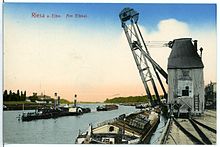Bucket elevator
A bucket elevator (also called elevator) is a conveyor machine for moving bulk material upwards in a vertical position. The bucket elevator thus falls into the category of continuous conveyors .
V-shaped containers made of steel or plastic are attached to a double or central chain strand , an articulated chain or a belt ( belt bucket elevator )
- are continuously loaded with material via chutes or chutes ,
- convey this upwards in the troughs or cups on the chains or the belt
- and dump it onto an unloading chute behind the upper reversing station ( paternoster ).
A bucket elevator has an upper station (with drive shaft, motor and gear) and a lower reversing station. The steel elevator shafts for the upward and downward movements between the diversion stations are called "bucket elevator chimneys" or "shafts".
Bucket elevators require a very high drive power depending on the overall width, the capacity of the containers and depending on the conveying height. Due to the weight of the buckets and chains, the delivery heights are limited. There is hardly ever an upward movement of more than 120 meters. These delivery heights are reached in cement works in order to convey the limestone-raw meal mixture from the silos into the heating technology section up to the preheater tower. It is possible to connect two bucket elevators in series with an intermediate gutter so that greater heights can be reached.


